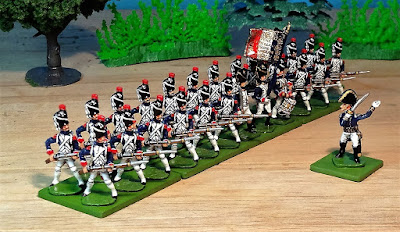How does one say thank you? You know, properly, in a sincere and manly way, without sounding like a gushing nitwit?
In New Zealand, the land of stunning understatement, the approved method is to stare at your feet, take a deep breath, and then very rapidly mutter "aaaawww, cheers mate" in a deep, gravelly and barely audible manner, followed by coughing.
It's a massive problem for me. I'm continually being humbled by the industrial-strength generosity of complete strangers who read my blog and then send me treasures beyond all imagining. The torture is refined when they absolutely refuse to take anything in return.
The latest Wellington Man-humbler is Rob. Rob doesn't collect Hinton Hunts, so when he acquired some when he was really after something else, he sent his unwanted surplus to me. Here's a picture of them.
The figures are Hinton Hunt:
FN 36: French Artillery Driver x 9
H 3: French (nearside) Gun Horse x 9
H4: French (offside) Gun Horse x 9
There's enough there for four gun teams, with a pair to spare. Rob also threw in spare muskets sufficient to equip a battalion and a couple of SHQ French 12 pdrs (not pictured) for good measure.
Not only did Rob fill a gap, but he also solved a problem, which was how to finish off the Phase One French. I was dithering about this something terrible the whole time I was painting the 7th Lancers.
Once I was able to get up close and personal with the FN 36s, I could see that they are actually guard artillery drivers! Their tall plumes, fancy waistcoats and dainty little hussar boots leave no room for doubt. Now, it just so happen that I have a Hinton Hunt Foot Artillery of the Guard set to go with them, and some infantry that I've been dying to paint up as guardsmen for ages.
My guard infantry are Der Kriegslpielers
220: Dutch Grenadier Battalion, Defending. As soon as I saw these I knew they'd do very well as Old Guard Chasseurs à Pied. All they needed was a little paint conversion on the cuffs. Readers may remember that I also used a few of these for my Swiss battalion.
Progress to date is pictured below, with the Swiss grenadier versions included by way of comparison.
Commanding them will be three really splendid examples from the Der Kriegspielers set number 20:
French Guard Infantry Command. This set included both Chasseur and Grenadier variants. Pictured below are the Chasseur marching officer, standard bearer and drummer. Their bases are marked: "CHASS 20", which is rather helpful.
Yes, I know, it's not exactly "painting them as intended", which I've been a bit pious about in the past. However, I have another battalion, and they really are going to be Dutch Grenadiers!
The last three shots were supplied by Rob. They show his breathtakingly magnificent Spencer Smiths, complete with his superb hand-made buildings and terrain. Rob even supplied some of the plans. The bridges explode, and the buildings lift up to reveal ruins beneath! Wonderful, wonderful, wonderful.
Aaaww, cheers mate. *cough*
WM
EDIT: As LewisGunner reveals in his comments below, the Artillery Drivers are actually Hinton Hunt FN 188 rather than FN 36 as I originally assumed.





















